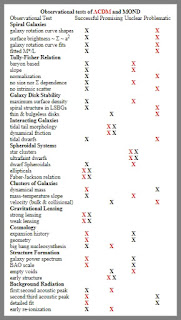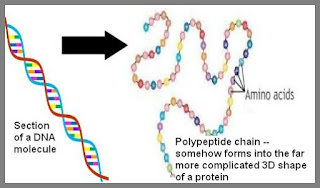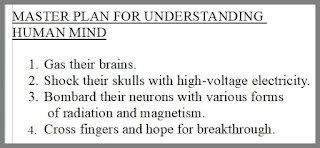For
reasons I discussed in my previous post and also in this longer post, the evidence is overwhelming
that a specification for the human body plan does not exist in DNA.
But some scientists continue to push the myth that DNA is a
specification of the human body plan. An example of a scientist doing
such a thing is a recent book entitled How to Code a Human: Exploring
the DNA Blueprints That Make Us Who We Are by biologist Kat Arney.
Arney's wavering claims about DNA flip-flop all over the map, and we
can frequently find one claim she makes on this matter that
contradicts other claims she makes on this matter.
Let
us look at the wildly inconsistent claims that Arney makes about DNA.
Claim
#1: DNA simply has recipes for making molecules. This relatively
modest claim is made on page 9 of Arney's book, where she says,
“Genes are recipes for making molecules.” The same claim of genes
as recipes is made on pages 34 to 35. Even this relatively modest
claim is not correct, because DNA merely specifies an ingredient list
for molecules such as protein molecules. DNA does not specify the
three-dimensional shapes that such molecules need to have in order to
be useful.
Claim
#2: DNA consists of genes that are “living entities.” On page 8
of her book Arney says this:
Instead
of being like computer code, with tidy electrical circuits, genes are
more like recipes. They are living entities, full of constantly
shifting molecules and with many options for flexibility, depending
on the range of things a cell needs to manufacture.
In
this statement, we have multiple glitches. First, computer code does
not contain electrical circuits. Second, genes (particular sections
of DNA) are chemical units (fractions of a molecule) that are not
living entities. Third, you contradict yourself very obviously if
you first say that a gene is a recipe (a lifeless, inert thing), and
then in your next sentence claim that a gene is a living entity.
Fourth, a gene is part of a DNA molecule, not something “full of
constantly shifting molecules.”
Below
is an example of a recipe, and it includes both an ingredient list
and assembly instructions. Neither DNA nor the genes in it are
recipes, for they do not contain any assembly instructions.
Nowhere in DNA or one of its genes is there anything like an assembly
instruction for making a cell, a tissue, an organ, an organ system,
an appendage such as an arm, or a full organism. DNA is written in a
bare-bones “amino acid language” that is so lacking in expressive
capability that it is impossible that DNA could ever even have assembly
instructions for a simple cell, a unit of such complexity that it is often compared to a small city.
Recipes include assembly instructions
Claim
#3: DNA is like computer code, and “directs the processes of life.”
The title of Arney's book about DNA is “How to Code a Human.” The title implies that DNA is like some
computer software that specifies the functionality of how human
biology works. Also on page 6 Arney tells us that “the genetic
information encoded in our DNA directs the processes of life.” But such a
claim is inaccurate. Since DNA has only one-dimensional information
specifying chemical ingredients, it could not possibly be something
that “directs the processes of life.” And claims about DNA being
like computer code that “directs the processes of life” are inconsistent with Arney's claim on page 8 that “instead of being
like computer code” genes are “more like recipes.” Recipes
don't direct things.
Claim
#4: DNA is some kind of agent that directs embryonic development.
This claim is made on page 116 where Arney claims that genes “direct
embryonic development” and that “genetic rules and patterns" guide embryonic development. These claims are contradicted by her
confession on page 7 that “scientists are only just beginning to find
the answers to some really big questions such as: how does a
fertilized egg divide and specialize to make all the tissues of the
body?” When a scientist says that his colleagues are “only just beginning to find the answers” to some matter, it essentially means
they don't understand the matter and know almost nothing about it. So
how then can Arney possibly be claiming that genes “direct
embryonic development”?
Arney
provides no evidence to back up her claim that genes “direct
embryonic development,” other than mentioning the feeble evidence
of Hox genes, the role of which is murky. Having failed to back up
this claim, she resorts on page 125 to saying, “There is not enough
space in this book to go into the details of human development and
the genes that direct it.” We may be forgiven for concluding that
the real reason she is not listing any solid evidence for the claim
that genes direct embryonic development is that such evidence does
not exist and cannot possibly exist (given the expressive limits of
DNA), not that there was not enough space in her book.
Claim
#5: DNA consists of blueprints. This claim is made in the subtitle of
Arney's book, which is “Exploring the DNA Blueprints That Make Us
Who We Are.” The claim the DNA consists of blueprints is
inconsistent with Arney's previous claim that DNA consists of recipes.
A blueprint is a specification of the three-dimensional layout of
something, and according to the usual understanding of a blueprint, a
blueprint does not include assembly instructions. In this sense it is
the opposite of a recipe, which does include assembly instructions,
but does not specify the exact physical layout of the final product.
The claim that DNA consists of blueprints is also inconsistent with
Arney's previous claims that genes “direct the processes of life”
and “direct embryonic development.” Blueprints are passive things
that don't direct anything. A blueprint is not an agent.
As
for claim #4 and claim #5, they are both explicitly debunked by
Agustin Fuentes, a professor of anthropology, who states the
following:
Genes
play an important role in our development and functioning, not as
directors but as parts of a complex system. “Blueprints” is a
poor way to describe genes. It is misleading to talk about genes as
doing things by themselves.
In
statements such as this, scientists "fess up" that the idea
of DNA as a human specification is not true. Two other scientists
"fess up" in a similar way when they write the following about genes in
the journal Nature: "Population
genetics is founded on a subset of coding sequences that can be
related to phenotype in a statistical sense, but not based on
causation or a viable causal mechanism."
Regarding
the DNA as blueprint idea (claim #5), a wikipedia.org article
entitled “Common misunderstanding of genetics” lists the claim
that “Genes are a blueprint of an organism's form and behavior”
as one of the “common misunderstandings of genetics.”
These five claims by Arney are wildly inconsistent, and all over the map. DNA
cannot be an agent and a director if it merely consists of
blueprints; and if it consists of blueprints, it cannot consist of
recipes; and if genes are blueprints, they cannot be like computer
code, which works totally different from a blueprint. When you hear
someone throwing out such a variety of claims that conflict with each
other, you should suspect that their claims lack a foundation in
fact. And that is the case here.
In
its article on “molecular genetics,” the Stanford Encyclopedia of
Philosophy says the following:
The
fundamental theory that says the role of DNA is to provide the
information for development has been criticized on many
grounds....Philosophers have generally criticized the theory that
genes and DNA provide all the information and have challenged the use
of sweeping metaphors such as “master plan” and “program”
which suggest that genes and DNA contain all developmental
information....It is not clear that they can elucidate the idea that
genes are "fundamental" entities that "program"
the development and functioning of organisms by "directing"
the syntheses of proteins that in turn regulate all the important
cellular processes. In fact, there is considerable skepticism in the
philosophical community about this fundamental theory.
Another
relevant article in the Stanford Encyclopedia of Philosophy is its
article on developmental biology. That article tells us that there
is no theory explaining how the development of an organism occurs.
We read the following:
It
is uncommon to find presentations of developmental biology that make
reference to a theory of development. Instead, we find references to
families of approaches (developmental genetics, experimental
embryology, cell biology, and molecular biology) or catalogues of
“key molecular components” (transcription factor families,
inducing factor families, cytoskeleton or cell adhesion molecules,
and extracellular matrix components). No standard theory or group of
models provides theoretical scaffolding in the major textbooks (e.g.,
Slack 2013; Wolpert et al. 2010; Gilbert 2010). The absence of any
reference to a theory of development or some set of core explanatory
models is prima facie puzzling. Why is it so difficult to identify a
constitutive theory for developmental biology?
These
assertions contradict Arney's claim that genes “direct embryonic
development.” Evidently such a theory has not become very
widespread, for the quote above makes clear that there is simply no general theory of what causes embryonic development.
Arney
contradicts herself all over the place when talking about DNA and
genes. A similar lack of consistency on this topic is found in an
Aeon essay by biologist Itai Yanai. Below is a quote:
At
the most fundamental level, then, our genome is not a blueprint for
making humans at all. Instead, it is a set of genes that seek to
replicate themselves, making and using humans as their agents. Our
genome does of course contain a human blueprint – but building us
is just one of the things our genome does, just one of the strategies
used by the genes to stay alive.
The
biggest problem here is not the anthropomorphic nonsense about genes seeking things and “using humans
as their agents,” but the glaring contradiction of saying in one
sentence “our genome is not a blueprint for making humans at all,”
and then saying two sentences later, ”Our genome does of course
contain a human blueprint.” That's
another case of a scientist saying something false, and adding an “of
course” to compound the error. See this post for why
genes and DNA cannot be truthfully considered a blueprint for a
human being.
In
this post entitled “DNA is a recipe, NOT a blueprint,” a PhD
student in “molecular evolution” debunks the claim that DNA is a
blueprint, asserting emphatically, “Describing the genome as a
blueprint is a recipe for disaster.” But the author then asserts
the equally incorrect idea that DNA is a recipe, saying it “is
much more accurate” to describe DNA as “a recipe or set of
instructions for making the organism.” No, it no more accurate to
describe DNA as a recipe than to describe it as a blueprint, because
there is in DNA no “set of instructions for making the organism,”
no set of instructions for making an organ system, no set of
instructions for making an organ, no set of instructions for making a
tissue, no set of instructions of making a cell, and not even a lowly
set of instructions for making a single three-dimensional protein
molecule. DNA has merely the chemical ingredient lists of proteins.
Advancing
the Great DNA Myth that DNA is a human specification, our biologists
flip flop all over the map, contradicting each other, with a single
biologist often contradicting himself or herself on this topic.
Jonathan
Latham has a master's degree in Crop Genetics and a PhD in virology.
In his essay “Genetics Is Giving Way to a New Science of Life,” a
long essay well worth a read, Latham exposes many of the myths about
DNA. He states the following:
A
standard biology education casts DNA (DeoxyriboNucleic Acid) as the
master molecule of life, coordinating and controlling most, if not
all, living functions. This master molecule concept is popular. It is
plausible. It is taught in every university and high school. But it
is wrong. DNA is no master controller, nor is it even at the centre
of biology....Does DNA have any claim to being in control? Or even
just to be at the centre of biological organisation? The answer is
that DNA is none of the things Watson, Lander, and Collins claim
above, even the standard, supposedly nuanced, biologist’s view of
life is wrong...The evidence that DNA is not a biological controller
begins with the observation that biological organisms are complex
systems. Outside of biology, when we consider any complex system,
such as the climate, or computers, or the economy, we would not
normally ask whether one component has primacy over all the
others.....Geneticists, and sometimes other biologists, make this
linear interpretation seem plausible, not with experiments—since
their results contradict it—but by using highly active verbs in
their references to DNA. DNA, according to them, “controls”,
“governs”, and “regulates” cellular processes....However,
there is no specific science that demonstrates that DNA plays the
dominant role these words imply. Quite the opposite....It is
habitually, but lazily, presumed that DNA specifies all the
information necessary for the formation of a protein, but that is not
true....How is it that, if organisms are the principal objects of
biological study, and the standard explanation of their origin and
operation is so scientifically weak that it has to award DNA
imaginary superpowers of “expression” and “control” to paper
over the cracks, have scientists nevertheless clung to it?
It seems that just as many of our theoretical physicists have taken to indulging in what may be called Fantasy Physics, such as string theory and multiverse speculations, many of our biologists have been indulging in Fantasy Biology. One of the main aspects of Fantasy Biology is the claim that DNA is a human specification, something it cannot be because of its own inherent expressive limitations, which must prevent it from specifying anything a hundredth as complex as a human specification. Another of the main aspects of Fantasy Biology is the claim that human memories are stored in synapses, a claim that cannot be correct because memories can last 50 years, but the average lifetime of a synapse protein is less than a month, which means writing to a synapse would be as unsuitable for permanent storage as finger-writing in the wet sand at the edge of a seashore. In both cases, Fantasy Biology commits the sin of ignoring a physical limitation that should have constrained our thinking on a topic.







